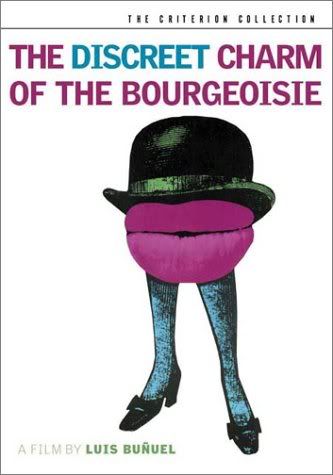
The classic structure of exposition, climax and resolution is staple for storytelling; though when challenged with the abandonment of logic and reasoning, the viewer is in for interesting film. And "The Discreet Charm of the Bourgeoisie," is with out doubt no exception to this rule; it opens the door for the arbitrary, the contradictory, the outrageously offensive, and the controversial—everything that makes great satire. This satiric story teases the viewer, as if telling a joke and hording the punch line. With obvious exaggerations in the story, it's apparent the Director, Luis Bunuel, is providing a riddle that's almost impossible to crack.
Bunuel, a Spanish director,creates a world that has roots to surrealism: dialogue, is mysteriously shadowed by harsh sounds, and dream sequences begin with out warning—the events all bizarre and impossible in our reality make perfect sense to bourgeoisie in the film; their precarious life style of drug trafficking, sex, expensive cuisine and rubbing elbows with politicians is apart of being high class; a life style opening the door for contradiction.
The story follows a group of bourgeoisie and the their acquaintance Don Rafael Acosta, ambassador of the fictional country Miranda—which the story alludes is some where in South America. Rafael is a drug trafficker with a pesky assassin from Miranda on his tail. His coterie of high class makes the attempt to sit down for dinner, lunch and tea, yet their plans are foiled every time. And with every spoiled meeting, they seem become more acceptant of these odd disturbances.
Hilariously, this group of individuals, schooled in propriety, is anything but genuine and refined: the hostess for the gatherings decides to keep her guest waiting in order to have sex. Because of the long wait, her guests leave in fear of being raided by the police.
Being from a middle class background, I watched the ambiguity with a smile. Old clichés, over used yet rarely incorporated in daily life, come to mind: There’s two sides to every story, and everything that glitters isn't gold. The Bourgeoisie were very rich and very flawed. Oddly, every where on Earth, practices of the lower class are written off as inferior: sipping a martini as opposed to gulping it down takes precedence over tolerance and acceptance. And if viewed carefully, I feel Bunuel’s stretches his themes towards the U.S.
Rafael, an ambassador, candidly mentioning the arrest of a U.S Ambassador for drug trafficking was a red flag. A Cadillac, a tank in the streets of Paris, for me was another. I’ve watched this film twice, and I’m sure it will take a few more sittings to absorb as much from this film as I can. I honestly feel the bizarre elements in this form of expression are not to be wholly understood. And many other elements are strictly for the filmmaker’s personal satisfaction. I see this film as an invitation into some one’s worldview. Fortunately for Bunuel he was free from constraint, free from the usual shape and aesthetic viewers become accustomed to,ultimately,in the end,carving his imagination as he saw fit.
No comments:
Post a Comment